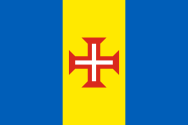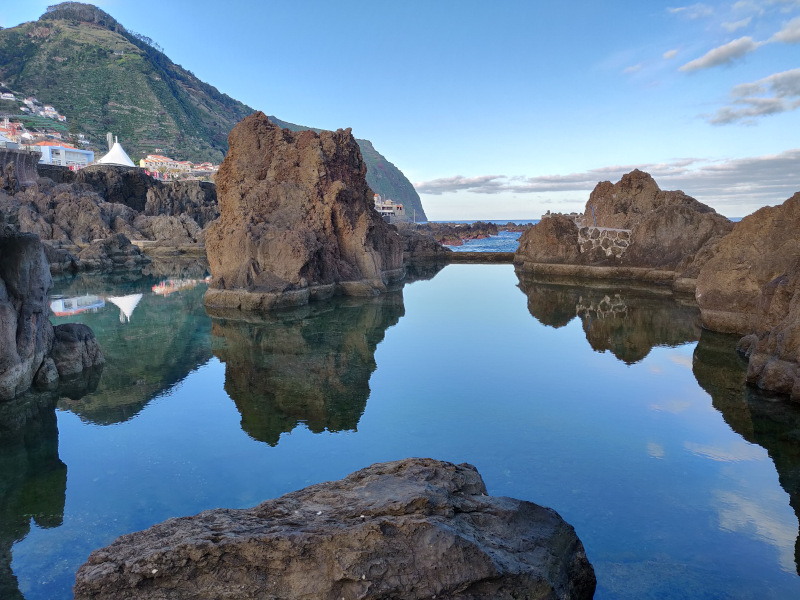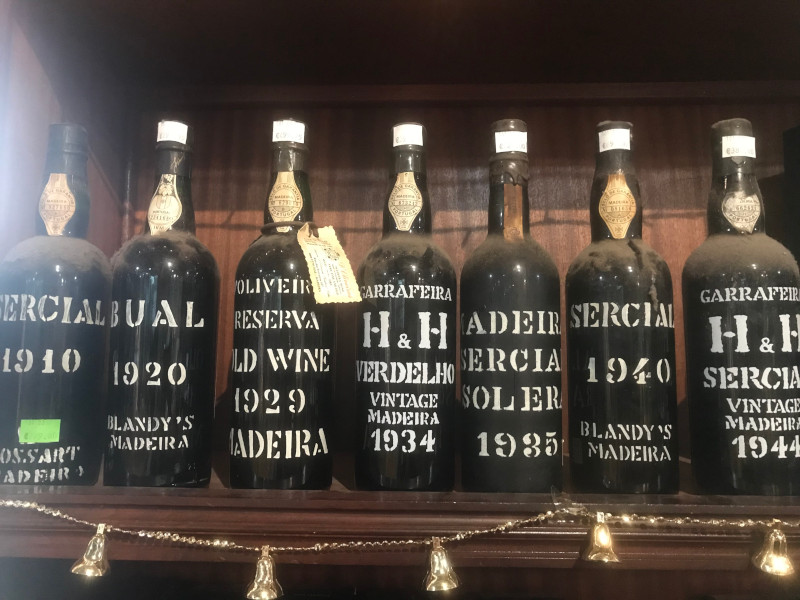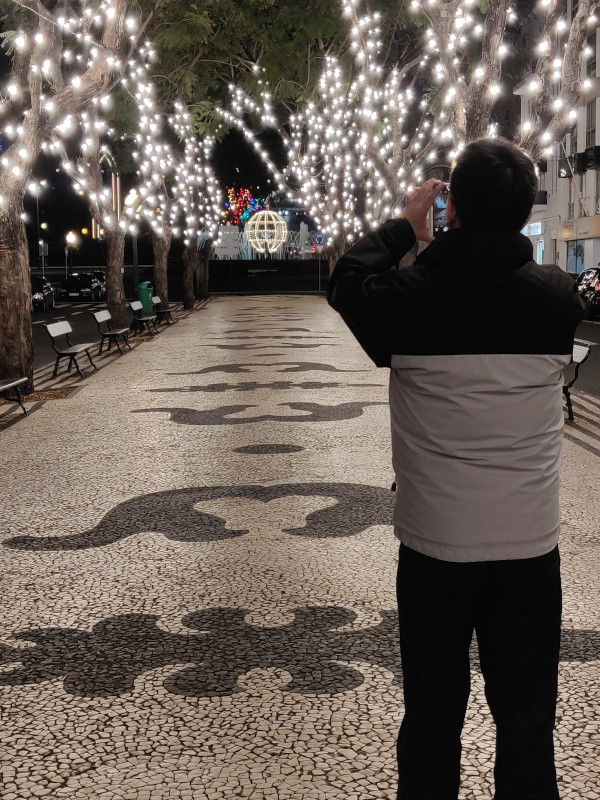- Travel + Photos
- Voyages
- Madeira
Madeira

Where to go to escape from the gloomy and cold weather of Paris in the winter? My brother proposed Madeira as destination. Et hop! 3:30 hours later (direct flight), here we are in Funchal, the capital of the Autonomous Region of Madeira (Região Autónoma da Madeira).
The archipelago of Madeira, situated in the North Atlantic Ocean, is comprised of the island of Madeira, Porto Santos and the Desertas. Togeather, the islands form an autonomous region of Portugal. The remainder of this article only talks about the island of Madeira, as it's the only island that we visited.
The island
Many flattering names have been given to the island of Madeira to evoke its remarkable beauty: l'île aux fleurs (island of flowers), le jardin de l'Atlantique (garden of the Atlantic), la perle de l'Atlantique (pearl of the Atlantic) etc. Born from volcanic eruptions during the tertiary period, the island abruptly pops out of the Atlantic Ocean to reach 1862 m (6106 ft) at its highest peak (Pico Ruivo). Consequently, Madeira has spectacular landscapes with vertiginous cliffs (almost 600 m, 1960 ft above the sea) on the west and northwest side of the island. Because of the mountains, the island possesses many microclimates: there are more wind and precipitation on the north side than on the south side of the island. The interior of the island, where it's more mountainous, is often foggy or covered by low clouds.
Even in the winter, the wet season, the number of sunny days is more than acceptable. Being in the middle of the Atlantic ocean, in a subtropical zone, Madeira has a very temperate climate with a moderate annual temperature swing: there's less than 10° differential between the average min/max in winter (13/19°C, 55/66F) and in summer (19/26°C, 66/79F). That's probably why Paul Moran once wrote "cette île où l'été vient passer l'hiver" (the island where the summer comes to spend its winter).
To take advantage of the frequent precipitations on the north side of the island, Madeirians have constructed a network of levadas (aqueducts) to carry water to the south of the island, more arid, for agriculture irrigation. In all, there are more than 2170 km (1350 mi) of levadas, 40 km (25 mi) of which are tunnels. Nowadays, some levadas are used to produce hydro-electric power. One can also trek alongside the levadas, in some "breathtaking landscapes" (to quote Le Routard).
Beside the levadas, Madeira possesses numerous trekking trails offering spectacular views, among which are the trail between Pico do Ariero (1818 m, 5965 ft) and Pico Ruivo (1862 m, 6106 ft), and the trail of Ponta de São Lourenço. For outdoors enthousiasts, Madeira is almost a paradise. Almost, because with so many hikes to choose from, deciding which to do during your stay on the island is a real problem.
The gastronomy
Ah, the McDonalds... just joking. (That said, according to Google Maps, there are 3 on the island in the Funchal region).
Being an island, it's not surprising to find fish and shellfish on the menus. Some of the mainstays of maderian cuisine, not to be missed, are the espada (peixe agulha), the famous black scabbardfish, and the lapas grelhadas (grilled limpets). The fish is named espada (sword in portuguese) probably because of its long narrow body and its rasor sharp (scary) teeth. As to the lapas, the best I can describe is it's something in between mussel and clam.
The madeira, a fortified wine from Madeira, is well known. But wines on the island are not limited to just that fortified wine; numerous wineries produce different types of white wines: dry, semi dry and sweet (sercial, verdelho, terrantez). The local beer is known under the name of Dorale... that's all I will say about the beer. However, you can't leave the island without trying the poncha. Originated from Câmara de Lobos, the poncha is an alcoholic cocktail made from maracujá, aguardente de cana (rum) and orange juice or lemon juice. It's the most popular cocktail on the island and the most consumed. It's great to sip a poncha watching the sunset at the beach, but it's better not to drink too quickly as it's much stronger than it seems.
How about meats? The most traditional dish is the espetada. It's made of big pieces of beef, rubbed with garlic and salt, seasoned with leaves of laurel, then impaled on a sword... well not really a sword but definitely a huge skewer that is cooked over hot coals. The traditional espetada is with beef, but restaurants also propose espetadas with pork, chicken or even with squid or fish.
The jumble
Maderians speak galician-portuguese, a variant of portuguese that is pretty close to spanish, and are catholic in majority (88%).
Cristiano Ronaldo (the footballer) was born in Funchal. Thus it's no surprise that Funchal has a statue of him and a museum, Museu CR7, dedicated to his trophies. And not to mention that Madeira international airport bears his name.
There is a great number of Maderian descendants all around the world. That's part of the Portuguese diaspora, but also because of the famine on the island in the 1840s. Recently, a lot of them come back to Madeira, notably from Venezuela and South Africa, causing a lot of tension with the inhabitants of the island.
The road infrastructure of Madeira has been greatly developped in recent years. And because of the mountainous terrain, that translates into a lot of bridges and tunnels. It's much easier to visit the island thanks to those vias rápidas. That said, in the northwest of the island where it hasn't yet been well developped, it takes more time going from one town to another on the old roads.
At the Santa Cruz fair, one can order the espetadas by the weight of the meat. They cut the meat into big cubes, rub them with garlic and salt, and thread them on big wood skewers (more like branches of a tree). Then one can take those enormous brochettes and cook them onself over wood and coal fire on the beach
Practical details
Dates of the trip: 5 - 12 January 2019
Public transportation in Funchal is adequate, and there are buses between Funchal and the neighbouring cities. Otherwise, it's much more practical visiting the island by hiring a car.
There are much less tourists on the north side of the island, consequently a lot of services are closed during the winter season.
Copyright © 2021, Northwest Summit. All rights reserved.
No part of this page may be reproduced, republished or copied without the express written permission of its author.


